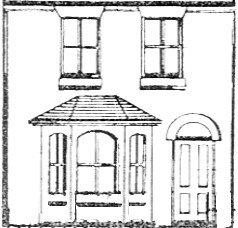Care & Repair
Interior mouldings and dado rails

The Victorian Society Guides
iii/ INTERIOR MOULDINGS & DADO RAILS
The Victorian Society is the most authoritative source of historical information on properties of this age.
What are mouldings made of?
Interior mouldings are usually made of either plaster or timber, although some applied decorations were also made out of compo, papier mâché or patent formulations.
What height should my dado rail be?
There is no hard-and-fast rule. Here are some points to consider:
- If you are reinstating a dado rail it is usually easy to see where it was originally installed, once the wall is stripped ready for redecorating
- If you are installing a new dado rail, it is helpful to consider the overall proportions of the wall: a high wall with a narrow frieze will require a deep dado.
- the dado rail originally protected expensive wall hangings from the backs of chairs; the point at which the chair-back brushes the wall determines the height of the rail.
- a dado rail on a staircase wall should match the height of the handrail on the banisters.
- if the dado is to be wallpapered, the pattern repeat may influence the height of the rail
- wallcoverings specially designed for dadoes, such as Lincrusta, may also dictate the precise height of the rail.
Did every Victorian reception room have a ceiling rose?
No. Bedrooms and attic rooms, servants’ quarters and domestic offices were usually given the minimum of architectural decoration.
You can usually tell if a rose has been removed, from unevenness where the ceiling plaster has been patched. When reinstating ceiling roses, align them with the centre of the chimneybreast (which may not be the geometric centre of the ceiling).
How can I remove old paint from plaster mouldings?
There are lots of proprietary paint stripping formulations on the market. Follow the manufacturer’s instructions and any warning labels. Wear protective clothing, gloves and goggles. Distemper may be impervious to some strippers. Steam may help to soften it enough to enable it to be chipped out by hand, using wooden sticks, dental picks and old toothbrushes.
All the interior mouldings were stripped out of my house. How can I find out what was there originally?
You will need to do some detective work:
- look for evidence of old decoration: bumps in plasterwork (which may show up better under a raking light), old fixing holes, hardboard or plywood covers on doors and banisters.
- look at neighbouring houses of similar age and style, to see whether they retain their original mouldings. Ask you neighbours if you can sketch, photograph and measure the mouldings.
- look at books about Victorian interiors
- visit preserved Victorian interiors that are open to the public.
Should I pick out the detail of my cornice in different paint colours?
Why not, if you have the patience and the result doesn’t look too fussy? Painting is reversible, so it is not a disaster if you get it wrong.
















